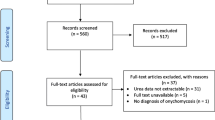Abstract
Objective: To review whether oral terbinafine, used for fungal nail infections, is prescribed appropriately by general practitioners Method: Cross‐sectional survey of forty volunteer practices. Prescribing systems were searched to identify patients who had been prescribed a course of oral terbinafine during 1998. The clinical records of five such patients in each practice were examined for additional information regarding appropriate diagnostic tests.Results: Five hundred sixty‐nine patients (0.25% of the population aged 12 and over) were reported to have received a course of oral terbinafine. Sixty‐four percent had been treated empirically without any recorded diagnostic test.Conclusion: Treatment of onychomycosis with terbinafine is commonly undertaken without diagnostic confirmation. This empirical treatment does not comply with locally recommended good practice.
Similar content being viewed by others
References
Denning DW, Evans EGV, Kibbler CC, Richardson MD, Roberts MM, Rogers TR et al. Fungal nail disease: a guide to good practice (report of a Working Group of the British Society for Medical Mycology). BMJ 1995; 311: 1277–81.
Roberts DT. Prevalence of dermatophyte onychomycosis in the United Kingdom: results of an omnibus survey. Br J Dermatol 1992; 126 (Suppl 39): 23–7.
Scher RK. Onychomycosis is more than a cosmetic problem. Br J Dermatol 1994; 130 (Suppl 43): 15.
Whittam LR, Hay RJ. The impact of onychomycosis on quality of life. Clin Exp Dermatol 1997; 22: 87–9.
Evans EGV, Sigurgeirsson B for the LION study group. Double blind, randomised study of continuous terbinafine compared with intermittent itraconazole in the treatment of toenail onychomycosis. BMJ 1999; 318: 1031–35.
Havu V, Heikkila H, Kuokkanen K et al. A double-blind, randomised study to compare the efficacy and safety of terbinafine (Lamisil) with fluconazole (Diflucan) in the treatment of onychomycosis. Br J Dermatol 2000; 142: 97–102.
Department of Health. Prescriptions dispensed in the community statistics for 1989 to 1999: England. Statistical Bulletin 2000, 20 August 2000.
Amichai B, Grunwald MH. Adverse drug reactions of the newer oral antifunfal agents: terbinafine, fluconazole, and itraconazole. Int J Dermatol 1998; 37: 410–5.
Wharry S. FDA issues warnings about drugs used to treat fungal nail infections. CMAJ 2001; 164: 1738.
Gupta AK, Shear NH. A questionnaire study on the management of onychomycosis: a Canadian perspective. Int J Dermatol 1998; 37: 457–60.
Author information
Authors and Affiliations
Rights and permissions
About this article
Cite this article
Wilcock, M., Hartley, J. & Gould, D. Inappropriate use of oral terbinafine in family practice. Pharm World Sci 25, 25–26 (2003). https://doi.org/10.1023/A:1022426309340
Issue Date:
DOI: https://doi.org/10.1023/A:1022426309340




